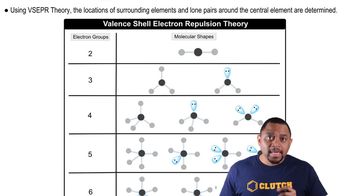Textbook Question
Give the approximate values for the indicated bond angles in the following molecules: (d)
1408
views
 Verified step by step guidance
Verified step by step guidance



Give the approximate values for the indicated bond angles in the following molecules: (d)
Ammonia, NH3, reacts with incredibly strong bases to produce the amide ion, NH2-. Ammonia can also react with acids to produce the ammonium ion, NH4+. (a) Which species (amide ion, ammonia, or ammonium ion) has the largest H¬N¬H bond angle? (b) Which species has the smallest H¬N¬H bond angle?
(b) How would you expect the H¬X¬H bond angle to vary in the series H2O, H2S, H2Se? Explain. (Hint: The size of an electron pair domain depends in part on the electronegativity of the central atom.)